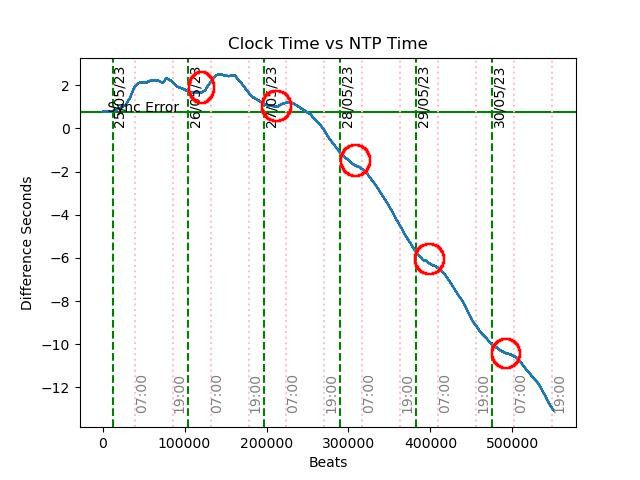Posted by Alan on 10/05/2023 10:24:42:
Have you tried running your own NTP server on your local network..??
This would give a lot less jitter (due to using the greater internet..)
Seems to be fairly easily done on a Raspberry Pi
https://www.satsignal.eu/ntp/Raspberry-Pi-NTP.html
is just one of many google hits on the subject….
I hope that I haven't sent you down another rabbit hole!!
Alan
Not yet Alan, but it's on my list. I have the necessary bits. I judge it to be a rabbit hole at the moment because my clock isn't accurate enough to challenge plain NTP yet. But if the clock improves as I hope, I will need to soup up NTP.
Worth repeating that althoughNTP isn't a good way of measuring individual beats, it is good for measuring pendulum clock performance over days, months, and years. From memory, I think the Shortt-Synchronome managed 8mS per year, compared with my Pi which in theory is always within 100mS, but in practice during the test run was within 30mS. In other words, over a year, NTP on an ordinary Raspberry Pi, is in the same ball-park as the best pendulum clock in the world. Further, synchronising NTP to GPS on the same Pi puts it into the 1mS region, roughly 8 times better than the best a Shortt-Synchronome could do.
I shall be pleased if I can get my clock to stay within 0.1s of UTC on a plain Pi, and ecstatic if the clock is good enough to force me to improve ordinary NTP. Unlikely I fear, but let's see.
As with all measurements, the tool should be about 10x more accurate than the object being measured.
Individual beat times are also interesting, and these are measured with a quartz crystal, which I can calibrate against to GPS once per second. Ordinary 100ppm Crystals are stable enough for indicative measurements down to about 0.1 microseconds, but poor over longer periods – worse than a cheap quartz kitchen clock.
Beyond what I'm up to, time nuttery gets even more exotic. Pendulums were surpassed as time-keepers in the 1930s by various electronic methods, each of which have in turn been surpassed by ever more accurate methods. Electronic oscillators took over from pendulums before pendulum clocks were fully developed, leaving the interesting possibility that an amateur could make a pendulum clock better than a Shortt-Synchronome, Reifler, Fedchenko, or similar high-end precision clock. It's a challenge!
Dave
Edited By SillyOldDuffer on 10/05/2023 11:49:45
SillyOldDuffer.




 S display ready for when the clock runs free-standing.
S display ready for when the clock runs free-standing.


